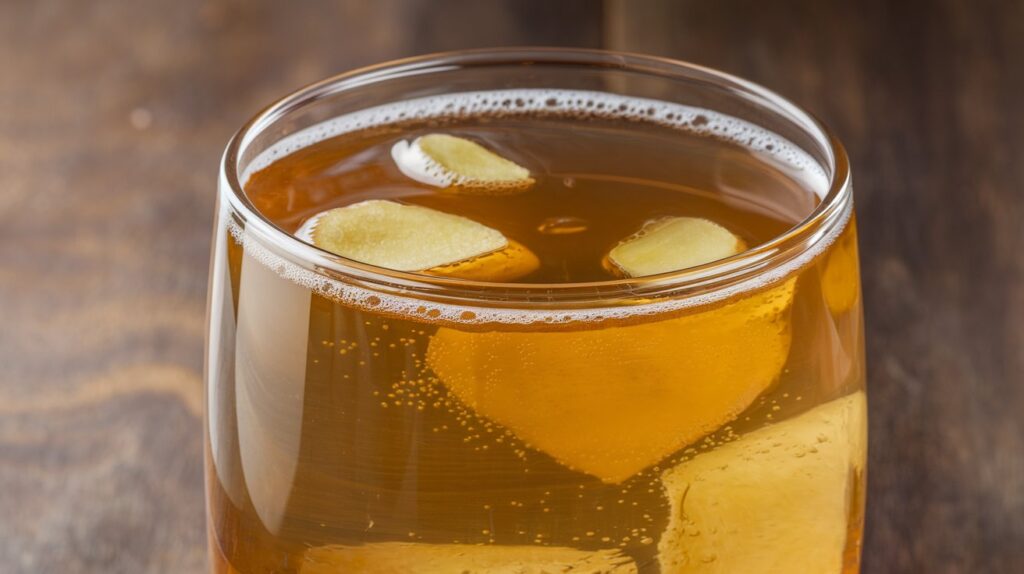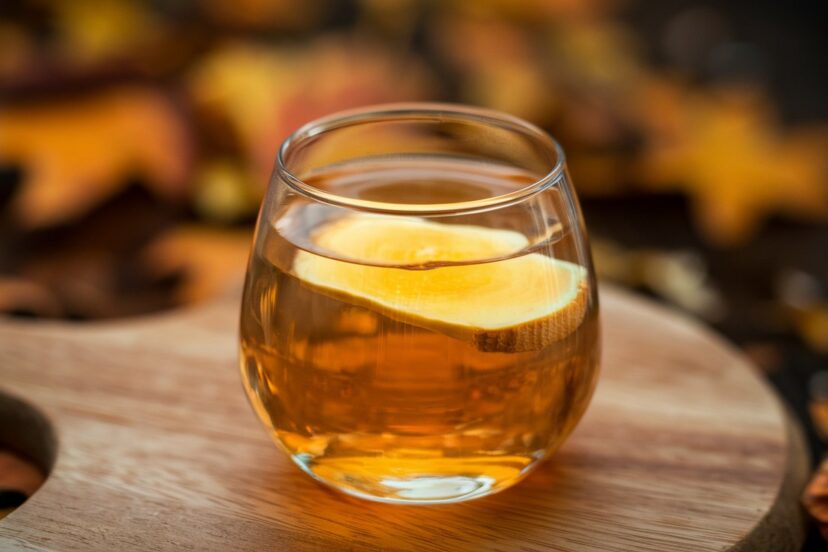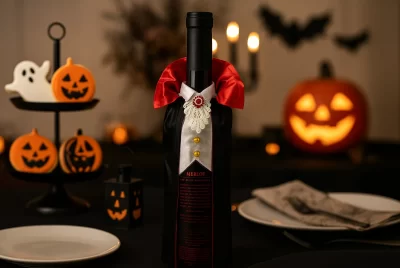How to Make Ginger Wine at Home?
Post Disclaimer
*We may earn a commission for purchases made using our links. Please see our disclosure to learn more.
As someone who’s been crafting homemade wines for over a decade, I can confidently say that making ginger wine is one of the most rewarding home brewing experiences. The spicy warmth of ginger combined with the subtle sweetness of wine creates a unique beverage that’s perfect for both special occasions and cozy evenings at home. What makes ginger wine particularly special is its versatility; it can be enjoyed chilled in the summer months or served warm during the winter, making it a year-round favorite.
In this comprehensive guide, I’ll walk you through everything you need to know to make your own ginger wine, from selecting the best ingredients to bottling your finished product.
Key Takeaways
- Ginger wine takes approximately 4-6 weeks to ferment and another 2-3 months to age properly
- Fresh, organic ginger root produces the best flavor profile
- Proper sanitization is crucial for successful fermentation
- The ideal fermentation temperature range is 68-75°F (20-24°C)
- You can adjust the sweetness and alcohol content to your preference
- Quality of ingredients directly impacts the final taste
- Regular monitoring during fermentation ensures the best results
Recommended Equipment and Products
Before we dive into the process, here are some essential products I’ve personally tested and recommend for making ginger wine. While you might find cheaper alternatives, investing in quality equipment will save you frustration and ensure better results in the long run:
Ultimate Wine Making Equipment Starter Kit
The Ultimate Wine Making Equipment Starter Kit with a 6-Gallon Glass Carboy is perfect for beginners looking to create their own high-quality, home-brewed wine. This comprehensive kit includes everything you need to get started, such as a de-gassing wand and various essential tools for the winemaking process. Designed to brew 6 gallons of wine, it's the ideal solution for hobbyists and enthusiasts. Whether you're looking to craft your first batch or refine your winemaking skills, this kit offers all the equipment you need to get started on your winemaking journey.
- Complete Starter Kit – Everything you need to brew 6 gallons of wine in one package.
- High-Quality Materials – Includes durable glass carboy and essential tools for easy winemaking.
- Beginner-Friendly – Ideal for first-time winemakers with clear instructions and all necessary components.
- Price – The kit may be a bit of an investment for those new to winemaking.
- Large Setup – Requires a significant amount of space to set up and store the equipment.
- Some Additional Supplies Needed – Certain winemaking ingredients like yeast are not included in the kit.
The Ultimate Wine Making Equipment Starter Kit is the perfect choice for making ginger wine at home, thanks to its comprehensive set of high-quality tools and materials. The 6-gallon glass carboy provides ample space for fermentation, allowing you to brew larger batches of ginger wine. Its non-reactive glass ensures that the flavor of your wine remains pure, preserving the natural taste of ginger and any added spices.
This kit includes a de-gassing wand, which is essential for removing carbon dioxide during fermentation. This step ensures that your ginger wine is smooth, clear, and free from excessive fizz, providing a cleaner finish. The de-gassing process is crucial for ginger wine, as it helps to avoid off-flavors and allows the vibrant ginger flavor to shine through.
Designed with beginners in mind, the kit contains all the necessary equipment, such as fermentation locks, airlocks, and siphons, so you won’t need to buy any extra tools. The easy-to-follow instructions make it simple to brew and refine your ginger wine without the confusion of additional purchases or complicated steps. Whether you’re making your first batch or perfecting your recipe, this starter kit provides everything you need to make delicious, high-quality ginger wine.
With all the tools in one package, this kit is an excellent choice for those looking to craft their own homemade ginger wine and enjoy the rewarding process of brewing.
Lalvin EC-1118 Wine Yeast
Lalvin EC-1118 Wine Yeast is the ideal choice for homebrewers looking to make wine, cider, mead, or kombucha. This champagne yeast, available in a 10-pack of 5g sachets, is specifically designed for high fermentation performance and is known for its versatility across different alcoholic beverages. Saccharomyces cerevisiae, the active yeast strain, ensures a clean, reliable fermentation process that produces crisp, consistent results. Whether you're crafting your first batch or refining your winemaking skills, this yeast is a trusted choice for achieving quality results every time.
- Versatile Use – Perfect for making wine, cider, mead, and kombucha.
- High-Performance Yeast – Known for reliable and clean fermentation.
- Cost-Effective – 10-pack provides multiple batches of fermentation at an affordable price.
- Storage – Requires proper storage to maintain potency for future batches.
- Fermentation Speed – May take slightly longer to ferment compared to other yeast strains.
- Limited Flavors – Primarily designed for clean, neutral fermentation, which may not enhance certain flavor profiles.
Lalvin EC-1118 Wine Yeast is an excellent choice for making ginger wine at home due to its reliability and versatility. When crafting ginger wine, consistency and clean fermentation are key to ensuring the final product is smooth and well-balanced, and this yeast excels in both areas. The Saccharomyces cerevisiae strain used in EC-1118 is known for its robust fermentation capabilities, which can handle a range of sugars and ingredients, making it ideal for the natural sugars in ginger and any added sweeteners in your wine.
One of the main benefits of using this yeast for ginger wine is its ability to ferment at a wide range of temperatures, ensuring that your fermentation process will be successful even if your brewing environment fluctuates. Additionally, EC-1118 is a neutral yeast that allows the flavors of the ginger and any spices you include to shine through without overpowering them, giving your ginger wine a crisp, clean finish.
The yeast’s reliable fermentation process also helps avoid off-flavors or unexpected issues, which is especially important for beginners. With 10 individual sachets in each pack, you can make multiple batches of ginger wine, giving you the opportunity to perfect your recipe and craft the ideal wine. Whether you’re making a small batch to experiment with different flavor combinations or brewing larger quantities, Lalvin EC-1118 is a dependable yeast that delivers excellent, consistent results for your homemade ginger wine.
Star San Sanitizer
Five Star Star San - 16 Ounce Brew Sanitizer is the go-to choice for homebrewers and professionals alike who need a reliable and effective sanitizer. This high-foaming acid anionic sanitizer works quickly, with just a 30-second contact time, making it perfect for sanitizing your brewing equipment without the need for rinsing. The foam generated by Star San penetrates into cracks and crevices, ensuring complete coverage and eliminating harmful bacteria. Ideal for use on carboys, kegs, fermenters, kettles, and more, this sanitizer protects and passivates stainless steel when left to dry, ensuring the longevity of your equipment. The flavorless formula ensures your brew tastes as intended, without any unwanted aftertastes. This sanitizer is the top choice for many professional craft brewers, ensuring a clean, safe brewing environment every time.
- No-Rinse Formula – Saves time and ensures your equipment stays sanitized without the hassle of rinsing.
- Effective on Multiple Surfaces – Great for sanitizing various brewing equipment, from carboys to kettles.
- Quick Contact Time – Just 30 seconds to sanitize, making it fast and efficient.
- Requires Precise Dosage – Proper measurement is needed to avoid overuse or underuse for maximum effectiveness.
- High Foam – Can be messy for some users, especially when not used carefully.
- Limited Scent – Though flavorless, some may prefer a lightly scented product to mask the strong sanitizer smell.
Five Star Star San – 16 Ounce Brew Sanitizer is an essential product for anyone making ginger wine at home, as sanitation plays a crucial role in ensuring a successful fermentation process. Ginger wine, like other
What sets Star San apart for ginger wine making is its convenient no-rinse formula. After sanitizing, you can leave the equipment to dry without needing to rinse away any residue, which saves you time and effort. This is ideal for delicate processes like wine fermentation, where even small residues can impact the taste or introduce off-flavors. Since Star San is flavorless, you don’t have to worry about any unwanted tastes in your ginger wine, allowing the fresh, spicy flavor of the ginger to shine through without contamination.
For home winemakers, especially beginners, Star San’s quick 30-second contact time ensures a fast and efficient sanitization process. With its easy-to-use bottle and accurate dosing, it’s simple to apply to all your brewing equipment, providing peace of mind that everything is clean and safe for your ginger wine. Many professional brewers rely on Star San for its reliability and effectiveness, making it a trusted choice for ensuring your homemade ginger wine is as clean and pure as possible.
Auto-Siphon with Tubing
The Fermtech Auto Siphon Mini is the perfect tool for small-batch homebrewing and winemaking, including for those crafting delicious homemade ginger wine. Designed for liquid transfer with ease, it includes a 14" siphon wand, 6 feet of food-safe tubing, and a secure clamp. Its compact size fits containers with openings as small as 1" (25mm), making it ideal for hobbyists working with small quantities. The Auto Siphon Mini simplifies the transfer process with a single pump, ensuring smooth, spill-free liquid movement between your fermenters, bottles, or jars. Whether you're bottling your ginger wine or transferring it between containers, this siphon reduces mess and waste, helping you achieve a clean and efficient brewing process.
- Compact and Convenient – Perfect for small batches of ginger wine, it fits into tight spaces, making it ideal for homebrewers with limited equipment.
- Easy to Use – The one-pump siphoning action allows for smooth, effortless liquid transfer with minimal effort, reducing the risk of spills.
- Complete Kit – Includes all the necessary components, including a siphon wand, tubing, and clamp, for a hassle-free experience during the fermentation and bottling process.
- Size Limitation – Best suited for small batches, so it may not be ideal for larger wine-making projects.
- Tube Length – The 6 feet of tubing may be too short for some setups, requiring adjustments or additional tubing for taller containers.
- Fragility – The siphon wand, while durable, should be handled carefully to avoid any potential cracking or damage during use.
The Fermtech Auto Siphon Mini is an essential tool for making ginger wine at home, particularly when working with small batches. Its single-pump mechanism allows for smooth, consistent liquid transfer between containers, reducing the risk of contamination and ensuring that no oxygen or bacteria spoils the brew. This is crucial for preserving the fresh, spicy flavors of your ginger wine.
With a compact design, the Auto Siphon Mini fits perfectly into smaller fermenters or bottles, making it ideal for home winemaking. The included 6 feet of food-safe tubing gives you enough length to reach most containers, and the secure clamp helps keep everything in place during use, minimizing spills and messes.
When making ginger wine, transferring your wine between fermenters or into bottles requires precision to prevent oxidation, which can affect flavor. The siphon ensures a smooth, steady flow, helping to maintain the integrity of your wine while preventing exposure to unwanted elements.
The Fermtech Auto Siphon Mini is easy to use, reliable, and durable, making it the perfect addition to any ginger wine maker’s toolkit. Whether you’re bottling or moving your wine to a secondary fermenter, this siphon guarantees a clean, efficient transfer every time, allowing you to focus on creating the perfect batch of ginger wine.
Understanding Ginger Wine Basics
Before we get into the process, it’s important to understand what makes ginger wine unique. Unlike grape wines, ginger wine is considered a “country wine” or fruit wine, even though ginger is technically a rhizome. The fermentation process converts the sugars we add into alcohol, while the ginger provides its characteristic spicy flavor and aromatic compounds. The addition of lemon helps balance the flavor and provides the necessary acid for fermentation.
The Complete Process
Ingredients Needed:
- 2 lbs fresh ginger root (preferably organic)
- 4 lbs granulated sugar
- 2 lemons (juice and zest)
- 1 packet wine yeast
- 1 tsp yeast nutrient
- 1 Campden tablet
- Water to make up to 1 gallon
- Optional: 1 cinnamon stick
- Optional: 2-3 cloves
Step 1: Preparing the Ginger
I’ve found that the key to exceptional ginger wine lies in how you prepare the ginger root. Start by thoroughly washing the ginger, but don’t peel it, as many of the aromatic compounds are just under the skin. When selecting ginger, look for pieces that are firm and have a fresh, spicy aroma. Avoid any pieces with soft spots or mold.
Slice it thinly or process it in a food processor until finely chopped. Some brewers suggest grating it, but I’ve found that chopping works better for extraction while making it easier to strain later. The size of your ginger pieces will affect the intensity of the flavor, smaller pieces will release more flavor but can be harder to strain out later.
Step 2: Making the Base
In a large pot, bring 2 quarts of water to a boil. Add your prepared ginger and reduce the heat to maintain a gentle simmer. After 15 minutes, add the sugar and stir until completely dissolved. The sugar dissolves more easily in hot water and helps extract more flavor from the ginger. Add the lemon juice and zest, then continue simmering for another 10 minutes. This creates what we call the “ginger tea” base.
If you’re using optional spices like cinnamon or cloves, add them during this simmering phase. These spices can add complexity to your wine, but use them sparingly as they can easily overpower the ginger flavor.
Step 3: Initial Fermentation Setup
Transfer your ginger tea to a sterilized fermentation bucket and add enough cool water to make up to one gallon, ensuring the temperature is below 80°F (27°C). Add one crushed Campden tablet and let it stand for 24 hours. This step is crucial as it eliminates any wild yeast or bacteria that could compete with your wine yeast.
The waiting period is non-negotiable, as adding yeast too soon after using the Campden tablet will kill it and prevent fermentation. Use this time to ensure all your equipment is properly sanitized and ready for the next steps.
Step 4: Starting Fermentation
After 24 hours, add the yeast nutrient and sprinkle the wine yeast over the surface. Don’t stir it in – let it rehydrate naturally for about 15 minutes, then give it a gentle stir. Cover the bucket with a clean cloth or put on the lid with an airlock installed.
The yeast nutrient is essential because ginger tea doesn’t naturally contain all the nutrients yeast needs for healthy fermentation. Without it, you might end up with stuck fermentation or off-flavors.
Step 5: Primary Fermentation
During the first week, stir the mixture daily to ensure good yeast distribution and to release trapped CO2. You should see active fermentation within 24-48 hours, indicated by bubbling and a slightly foamy surface. Keep the fermentation vessel in a dark place at room temperature (68-75°F).
During this phase, take hydrometer readings every few days. The initial reading should be around 1.090-1.100, and you’ll see it gradually decrease as the sugar is converted to alcohol. Keep a log of these readings – they’re invaluable for tracking fermentation progress.
Step 6: Secondary Fermentation
After 5-7 days, when the most vigorous fermentation has subsided, strain out the ginger pieces and transfer the liquid to a glass carboy using a sanitized siphon. Attach an airlock and let it continue fermenting for 3-4 weeks.
During secondary fermentation, you’ll notice the wine becoming clearer as sediment falls to the bottom. This is normal and desirable. Resist the urge to disturb the carboy during this time.
Step 7: Aging and Bottling
Once fermentation has completed (no bubbles in the airlock for several days and a stable hydrometer readings), rack the wine into another sanitized carboy, leaving the sediment behind. Let it age for at least 2 months – though I recommend 3-6 months for the best results.
When ready to bottle, you can back-sweeten if desired, but remember to add potassium sorbate to prevent refermentation if you do. Before bottling, take a final hydrometer reading, it should be around 0.995-1.000 for a dry wine.
Advanced Tips for Success

- Always use new, fresh spices and ingredients
- Keep detailed notes of your process and measurements
- Maintain strict sanitization practices
- Be patient during the aging process
- Store bottles in a cool, dark place
- Consider using oak chips during aging for added complexity
- Experiment with different types of ginger for varied flavor profiles
- Try blending with other fruit wines for unique combinations
Troubleshooting Common Issues
Slow or Stuck Fermentation
If fermentation seems slow or stops completely, check the temperature first. Too cold or too hot can affect yeast activity. You can also try adding additional yeast nutrient or gently stirring to release trapped CO2.
Cloudy Wine
If your wine remains cloudy after several months, you might need to use a clearing agent like bentonite. However, patience often resolves this issue naturally.
Off Flavors
If you notice any unusual flavors, they might be due to:
- Fermentation temperature too high
- Wild yeast contamination
- Bacterial infection
- Poor quality ingredients
Conclusion
Making ginger wine at home is a rewarding process that combines both art and science. While it requires patience and attention to detail, the end result is a unique and flavorful wine that you can proudly share with friends and family. Remember that each batch will be slightly different, and that’s part of the charm of home winemaking. Don’t be afraid to experiment with different amounts of ginger or additional spices once you’ve mastered the basic recipe.
Frequently Asked Questions
Q: How long will homemade ginger wine last?
A: When properly stored in a cool, dark place, homemade ginger wine can last 1-2 years, though it’s best consumed within the first year for optimal flavor. Proper storage conditions are crucial for longevity.
Q: Can I use powdered ginger instead of fresh?
A: While possible, I strongly advise against it. Fresh ginger provides a more complex flavor profile and better fermentation characteristics. Powdered ginger can leave an unpleasant, muddy taste and doesn’t provide the same depth of flavor.
Q: What’s the typical alcohol content of homemade ginger wine?
A: Using this recipe, you can expect an alcohol content of 12-14% ABV, though this can vary based on the amount of sugar used and the yeast’s performance. You can calculate the exact alcohol content using initial and final hydrometer readings.
Q: Do I need to sterilize my bottles before bottling?
A: Absolutely! This is crucial for preventing contamination. Sterilize all bottles and equipment with a no-rinse sanitizer immediately before use. Even previously cleaned bottles need to be sanitized again before use.
Q: Can I reduce the amount of sugar in the recipe?
A: Yes, but keep in mind that sugar is necessary for fermentation. Reducing sugar will result in a drier wine with a lower alcohol content. For a lower-sugar drink, ferment fully and then don’t back-sweeten. You can calculate the final alcohol content based on the amount of sugar used.
















